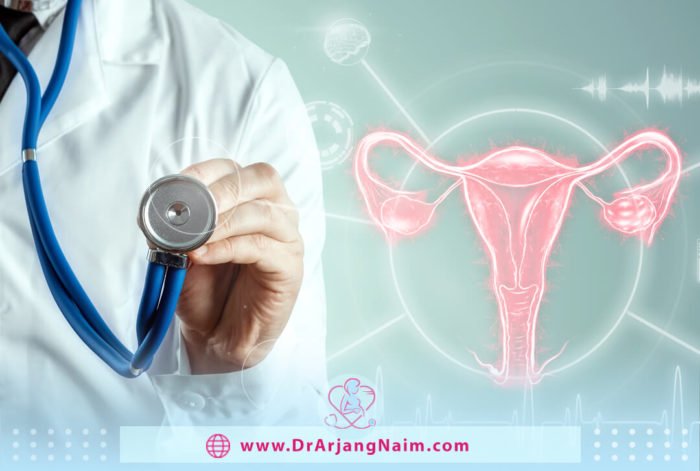Sudden abdominal or pelvic pain in a woman can be a sign of a ruptured ovarian cyst. Ovarian cysts are sacs full of fluid in or on the surface of the ovary. Women have two ovaries, each the size and shape of an almond on each side of the uterus. The egg, which grows and matures in the ovaries, is released during the menstrual cycle during the reproductive cycle.
Many women sometimes develop ovarian cysts. Most ovarian cysts show little or no discomfort and are harmless. Most of them disappear without treatment within a few months. However, ovarian cysts, especially torn ones, can cause serious symptoms. Symptoms of ovarian cyst rupture can usually be controlled with conservative treatment such as painkillers and rest. In some cases, a ruptured ovarian cyst may be complicated and may require surgery. Women who have severe ovarian cyst pain or other symptoms such as fever should see a doctor.
Types of ovarian cysts
The type of ovarian cyst makes a difference in the type of pain as well as when it is felt. Here are some types of cysts:
- Functional cysts: These cysts, also known as ovulatory cysts, are the most common type of cyst that usually has no symptoms. They can form as follicular cysts or as corpus luteum cysts.
- Dermoid or teratoma: These are cysts present at birth and include other tissues such as hair, bone, teeth, or skin. They are relatively rare, and it is estimated that about 10 out of every 100,000 women have this type of cyst.
- Cystadenoma: These form on the surface of the ovary and fill the ovary with fluid or tissue.
- Endometrioma: These are blood-filled cysts that grow on tissues outside the uterus.
Symptoms of a ruptured ovarian cyst

Rupture of the ovarian cyst can cause sudden pain in the pelvic area. The pain is usually severe and often on the right and bottom, but some cysts can be on both sides, such as the endometrium. The woman may feel pain after intercourse or during exercise. Ovarian cyst pain most likely begins in the middle of the menstrual cycle. Different types of cysts that rupture may cause pain at other times during the menstrual cycle. Symptoms of ovarian cyst rupture, in addition to pain, may include the following:
- Bleeding from the vagina
- Nausea
- Vomiting
- Tenderness in the pelvic
- Weakness
- Feeling faint
- Fever
- Increased pain while sitting
- Full or heavy feeling in the pelvis
- Shoulder pain
What causes a ruptured ovarian cyst?
Most functional cysts of the ovarian are the natural part of the women’s cycle and are more benign or non-cancerous. Other types of ovarian cysts like endometrium are not normal. Exactly the rupture of the cyst is not clear. But here are some possible risk factors:
- The history of rupture of ovarian cyst increases the likelihood of rupture of ovarian cyst
- Cysts can be torn after exercise and after sex
- Larger cysts may burst more easily
Diagnosing a ruptured ovarian cyst

If a woman observed the symptoms of the rupture of the cyst, it must be immediately consulted with her doctor. The doctor will ask about medical history and symptoms and a physical examination, including the pelvic examination. If the doctor is suspected of rupturing the cyst may need additional tests. The doctor wants to reject other diseases such as ectopic pregnancy, appendicitis, or kidney stones. Further tests may include:
- Ultrasound: The uterus ultrasound is a completely safe and painless method that produces images from women’s wombs using sound waves and helps detect bleeding and other uterine problems. Ultrasound gives information about the size and location of the cyst.
- Pregnancy test: If in doubt, the doctor will recommend a pregnancy test first. The doctor wants to see if pregnancy can cause cysts. If a woman is pregnant, the doctor chooses minimally invasive treatment options that do not put the baby at risk.
- Blood tests: Blood tests also show information about iron levels as well as cancer signs.
- Urine test: the doctor will look for protein in urine and other possible causes of pain.
- Vaginal culture: Used to check for pelvic infections.
- CT scan: This method uses a series of X-rays to provide a more accurate image of the pelvis.
What about cancer?
Ultrasound imaging is used to distinguish between a simple cyst such as an ovarian cyst and a more complex cyst. A complex cyst could potentially be a malignant or cancerous tumor. In general, a malignant tumor has internal structures that can be seen through ultrasound. But these structures do not necessarily mean that the cyst is malignant.
When an ultrasound scan finds an ovarian mass, some instructions indicate that the mass is most likely benign or malignant. If necessary, you will have surgery to evaluate and possibly remove the mass.
Malignant ovarian cysts are less common in young women. According to some studies, 13 to 21 percent of women who undergo surgery for ovarian cysts are malignant.
Treatment
Treatment for ovarian cyst rupture varies depending on whether the ovarian cyst is simple or complex. Simple cysts contain only fluid, while complex cysts may have solid areas, bumps on the surface, or several fluid-filled areas.
Ovarian cysts are not complicated in many women. Treatment of ovarian cysts is based on the symptoms. If the cyst is simple and asymptomatic or is accompanied by mild pain, no treatment is needed and treatment includes follow-up and use of analgesics, if necessary, then told the patient to check for symptoms over time and to Be careful of changes in the symptoms of ovarian cyst rupture. In some cases, an ultrasound may be done to further check for a ruptured ovarian cyst.
If a complicated ovarian cyst ruptures or a simple ovarian cyst that has symptoms (such as severe pain or bleeding), the patient should be hospitalized for further care. Necessary medical procedures in the hospital include the following:
- Injecting serum into the patient to replace lost fluids
- Accurate control of the patient’s heart rate and other vital signs
- Check the level of red blood cells to determine the ability of red blood cells to carry oxygen
- Repeat ultrasound to detect possible intra-abdominal bleeding
Surgery is performed if the symptoms of the disease become more severe and to check for cancer. If surgery is needed, the doctor may use less invasive procedures or laparoscopic surgery. The doctor may remove the ruptured cyst or sometimes the entire ovary. If laparoscopic surgery is not performed, the doctor must make a larger incision in the patient’s abdomen and remove the torn cyst with the help of a laparotomy.
Surgery

In some cases, laparoscopic surgery is recommended to stop the bleeding. Other factors that may indicate the need for surgery include:
- Cysts larger than 5 centimeters, depending on the type of cyst
- Persistent pain
- The possibility that imaged masses may not be benign
Some cysts larger than 5 cm don’t always need to be surgically removed; in the case of menopause, some simple cysts can be controlled. In the past, ruptured ovarian cysts with bleeding and low blood pressure were commonly treated with surgery. But depending on the type of cyst, many cases of ovarian cyst rupture can be conservatively controlled due to advances in imaging technology.
In cases where there are potential problems with some types of cysts, doctors may recommend taking oral contraceptive pills to prevent ovulation and cyst formation.
Complications of an untreated ovarian cyst
In most cases, the rupture of the ovarian cyst resolves independently, and the person may not know that the cyst was present. But if there are symptoms, you must see a doctor. Ignoring the symptoms can lead to the following complications:
- If the cyst bleeds, may have excessive blood loss.
- Endometrial rupture can be accompanied by heavy bleeding.
- If there is an infection, it is likely to spread. For example, rupture of a dermoid cyst may lead to peritonitis or perineal inflammation.
- A ruptured cyst can mimic or cause signs of ovarian torsion.
Prevention
There is generally no way to prevent an ovarian cyst from rupture. Sometimes, the doctor may notice the presence of an ovarian cyst during the examination of the patient, in which case, to prevent the cyst from rupturing, the doctor monitors the patient to determine the extent of the cyst changes with the patient’s revisit.
The bottom line
Ruptured ovarian cysts are part of the normal menstrual cycle and often resolve on their own. Functional cysts are not only common but also normal. But other types of ovarian cysts can be problematic if they rupture or cause pain or other symptoms.
If you have severe pelvic pain, see your doctor or go to the emergency room as soon as possible. Pelvic pain can have many causes, some of which can be life-threatening if left untreated. Most ruptured cysts can be treated with painkillers. But in some cases, you may need surgery to remove the cyst.
Additional questions
- Is a ruptured ovarian cyst serious?
Some ruptured ovarian cysts can cause heavy bleeding. These types of cysts require immediate medical treatment. In severe cases, blood loss can reduce blood flow to organs and cause dangerous complications.
- Can exercise reduce ovarian cysts?
Acupuncture and exercise can provide relief for women with polycystic ovary syndrome (PCOS).
- What exercise is good for the ovary?
Moderate exercise such as brisk walking, jogging, cycling, or swimming is all great activities that can help with PCOS. This type of exercise increases the body’s sensitivity to insulin, which reduces the risk of cardiovascular disease and type 2 diabetes.
- What to eat to shrink ovarian cysts?
Use lean proteins such as fish, tofu and chicken that maintain the balance of hormones. Fatty foods lead to inflammation. Foods rich in omega-3 help control the hormonal disturbances that occur in ovarian cysts.
- Can stress cause ovarian cysts?
Stress causes many health problems, but ovarian cysts are not one of them. Ovarian cysts are a common occurrence that often occur due to the normal course of the menstrual cycle. While stress does not lead to ovarian cysts, it may affect your ability to get pregnant in other ways.
References:
https://www.healthline.com/health/how-do-i-tell-if-i-have-a-ruptured-ovarian-cyst#takeaway
https://www.mayoclinic.org/diseases-conditions/ovarian-cysts/symptoms-causes/syc-20353405
https://www.webmd.com/women/what-to-know-about-ruptured-ovarian-cysts
https://www.verywellhealth.com/what-happens-if-i-have-a-ruptured-ovarian-cyst-2616648
https://www.fairview.org/patient-education/90243
https://www.nhs.uk/conditions/ovarian-cyst/treatment/




